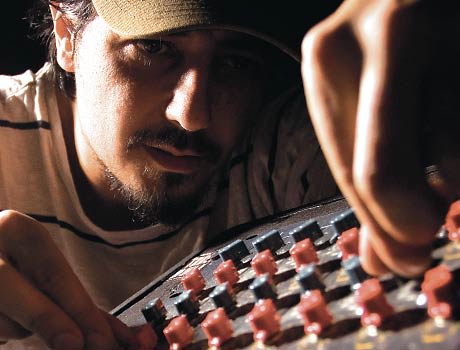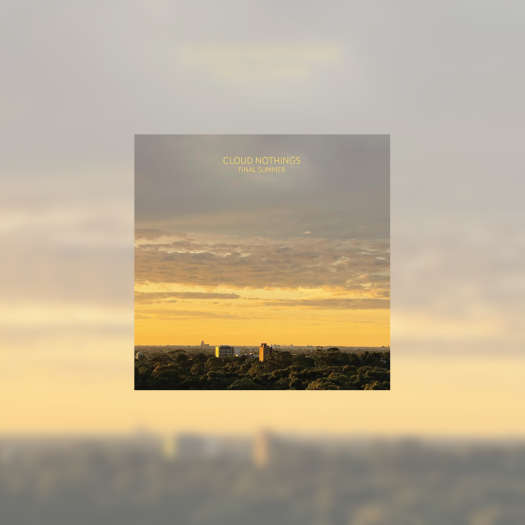Ninja Tune heavyweight Amon Tobin is, by his own account, a night owl. This leftfield sound collagist, whose musical history has mined the back alleys of jazz, drum & bass, and trip-hop, currently keeps a spacious duplex apartment in the business district of Old Montreal precisely because hes ensured the buildings around him will be empty after dark. He wants to avoid noise complaints. Tobins typical workday gets going late in the evening and often doesnt end until shortly before dawn.
Tobins studio is in a dark corner of his apartment thats been walled off by shelves stacked high with the vinyl he samples. The windows have been padded down with sofa cushions to prevent the sound of two large speakers from dribbling out onto the street. In between the speakers, hes arranged a mountain of digital and analog gear spanning two tabletops and a decades worth of technological innovation.
"Ive switched things around a lot in the last couple of years, he explains, as he showcases the studio. "I used to be all digital, but I think Ive come to realise that, in the end, I need to have a balance between the old and the new.
That desire to strike the perfect balance between the organic warmth of analog equipment and the high-fidelity perfection of digital innovation culminated around 2002, toward the end of recording Out From Out Where. For Tobin, that recording signalled the end of a five-year, four-album run that began in 1997 with Bricolage, his Ninja Tune debut. By 2002, his name had become synonymous with the more adventurous side of the 90s electronica boom; hed helped rejuvenate a London scene that had built up around the Coldcut-curated Ninja Tune roster. In search of a new creative direction, he moved across the ocean to Montreal and drastically altered the arrangement of his production console.
"Up to then, I was still digital, to varying degrees, says the soft-spoken producer. Afterwards, he made a decision to pursue his own creative musings outside the realm of technological advancement. "Now, when I pick up new equipment, its more a case of seeking out the tools to reproduce what Im imagining, rather than just asking for the latest gear on the market. If I need to do lots of analog to digital conversion, what do I need for that? If I need to get better EQ, what do I need to do? It sort of grows organically. Arguably, aesthetic reinvention is the lifeblood of the electronic music producer. Whereas many of the big names who counted as his peers in the late 90s Alex Reece and LTJ Bukem come to mind have since faded into footnotes after producing themselves into genre corners, Tobin had the sense to pause and reassess the creative direction of his musical output from a career-high vantage point.
After a three-year hiatus, in 2005 he returned with Chaos Theory, a first-of-its-kind soundtrack for the video game Splinter Cell 3 that succeeded in keeping the most excitable qualities of his first four albums his deep crates, the unpredictable nature of his composition while marrying them to a broader audiovisual mentality that allowed him to evolve beyond the restrictions of rhythm, toward the more atmospheric palate of electronic composition.
By his own admission, Splinter Cell 3 came along at the perfect juncture in his development. "The interesting thing about Splinter Cell is that, if you think about the average movie soundtrack and how many people it reaches, it would be very rare for somebody to make the music the way they wanted and still have it reach that many people. But because the game industry is still relatively young, theres still a lot of room for manoeuvring. This was a rare situation where I actually had carte blanche. As style goes, I was able to take it wherever I wanted. Since then, his work has become even more gleefully uncategorisable. For 2007s The Foley Room, Tobin stretched out even further, toward field recordings and live musicians. In his view, this wasnt so much a case of being limited by sampling as it was extending the breadth of his recording capabilities. Field recordings and musicians were simply "like having a new piece of gear, new sound to plunder.
That said, sampling from vinyl is still the cornerstone of his work. "I still think you can find just about any sound you want on vinyl. Many of the field recordings I did for this last project I could have probably found on vinyl. Its just that I have the added benefit of having some really talented people who were available and who were just much more fun in some respects because Id never worked with musicians and field recordings. But I still consider vinyl to be what inspires me. So far, that inspiration has resulted in six unparalleled albums.
Tobins studio is in a dark corner of his apartment thats been walled off by shelves stacked high with the vinyl he samples. The windows have been padded down with sofa cushions to prevent the sound of two large speakers from dribbling out onto the street. In between the speakers, hes arranged a mountain of digital and analog gear spanning two tabletops and a decades worth of technological innovation.
"Ive switched things around a lot in the last couple of years, he explains, as he showcases the studio. "I used to be all digital, but I think Ive come to realise that, in the end, I need to have a balance between the old and the new.
That desire to strike the perfect balance between the organic warmth of analog equipment and the high-fidelity perfection of digital innovation culminated around 2002, toward the end of recording Out From Out Where. For Tobin, that recording signalled the end of a five-year, four-album run that began in 1997 with Bricolage, his Ninja Tune debut. By 2002, his name had become synonymous with the more adventurous side of the 90s electronica boom; hed helped rejuvenate a London scene that had built up around the Coldcut-curated Ninja Tune roster. In search of a new creative direction, he moved across the ocean to Montreal and drastically altered the arrangement of his production console.
"Up to then, I was still digital, to varying degrees, says the soft-spoken producer. Afterwards, he made a decision to pursue his own creative musings outside the realm of technological advancement. "Now, when I pick up new equipment, its more a case of seeking out the tools to reproduce what Im imagining, rather than just asking for the latest gear on the market. If I need to do lots of analog to digital conversion, what do I need for that? If I need to get better EQ, what do I need to do? It sort of grows organically. Arguably, aesthetic reinvention is the lifeblood of the electronic music producer. Whereas many of the big names who counted as his peers in the late 90s Alex Reece and LTJ Bukem come to mind have since faded into footnotes after producing themselves into genre corners, Tobin had the sense to pause and reassess the creative direction of his musical output from a career-high vantage point.
After a three-year hiatus, in 2005 he returned with Chaos Theory, a first-of-its-kind soundtrack for the video game Splinter Cell 3 that succeeded in keeping the most excitable qualities of his first four albums his deep crates, the unpredictable nature of his composition while marrying them to a broader audiovisual mentality that allowed him to evolve beyond the restrictions of rhythm, toward the more atmospheric palate of electronic composition.
By his own admission, Splinter Cell 3 came along at the perfect juncture in his development. "The interesting thing about Splinter Cell is that, if you think about the average movie soundtrack and how many people it reaches, it would be very rare for somebody to make the music the way they wanted and still have it reach that many people. But because the game industry is still relatively young, theres still a lot of room for manoeuvring. This was a rare situation where I actually had carte blanche. As style goes, I was able to take it wherever I wanted. Since then, his work has become even more gleefully uncategorisable. For 2007s The Foley Room, Tobin stretched out even further, toward field recordings and live musicians. In his view, this wasnt so much a case of being limited by sampling as it was extending the breadth of his recording capabilities. Field recordings and musicians were simply "like having a new piece of gear, new sound to plunder.
That said, sampling from vinyl is still the cornerstone of his work. "I still think you can find just about any sound you want on vinyl. Many of the field recordings I did for this last project I could have probably found on vinyl. Its just that I have the added benefit of having some really talented people who were available and who were just much more fun in some respects because Id never worked with musicians and field recordings. But I still consider vinyl to be what inspires me. So far, that inspiration has resulted in six unparalleled albums.




